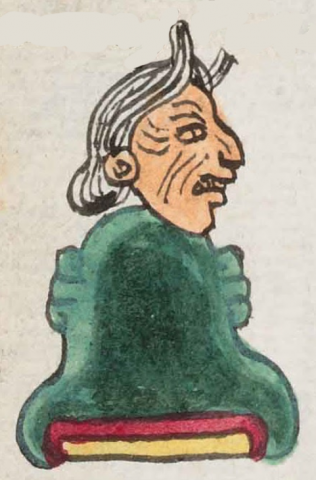Tonan Itlan (Mdz21v)
This is a multicolored painting of the compound glyph for the place name Tonan Itlan. This compound has two components, an older woman's head sitting atop a hill or mountain. The woman, facing to our right, is identifiable as such because of her hairstyle. For comparison, see the glyph for woman (cihuatl). Here, the woman represents the "tonan" part of the place name semantically, referring to "our mother" (to- is a possessive, plural, first person pronoun; -nan- is the stem for nantli). She has white hair, wrinkles, and possibly missing teeth, thus implying age, or something along the lines of "our female ancestor," but she could also be the sacred mother ancestor, Tonantzin. The hill (tepetl) is either a silent locative or stands for altepetl (pueblo, town). It is what Gordon Whittaker (2021, 75) calls a semantic complement. The remainder of the place name, which is spelled "ytla" in the original gloss, has inadvertently dropped its final -n. It should be Itlan, resulting in "next to our mother." Perhaps the fact that her teeth are showing can be taken as representing tlantli (the phonetic visual for the locative suffix for - i).
Stephanie Wood
Stephanie Wood
tonanytla, puo
Tonanitlan, pueblo
Stephanie Wood
c. 1541, but by 1553 at the latest
Stephanie Wood
nombres de lugares

to- (possessive pronoun), https://nahuatl.wired-humanities.org/node/175783
nan(tli), mother, https://nahuatl.wired-humanities.org/content/nantli
-itlan, next to, https://nahuatl.wired-humanities.org/content/itlan-0
-tlan (locative suffix), place, https://nahuatl.wired-humanities.org/content/tlan
Codex Mendoza, folio 21 verso, https://digital.bodleian.ox.ac.uk/objects/2fea788e-2aa2-4f08-b6d9-648c00..., image 53 of 188.
The Bodleian Libraries, University of Oxford, hold the original manuscript, the MS. Arch. Selden. A. 1. This image is published here under the UK Creative Commons, “Attribution-NonCommercial-ShareAlike 3.0 License” (CC-BY-NC-SA 3.0).


